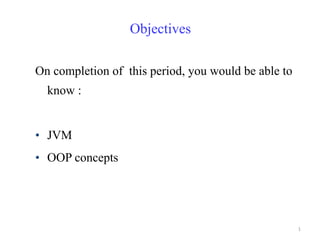
Oops
- 1. Objectives On completion of this period, you would be able to know : • JVM • OOP concepts 1
- 2. OOP Concepts The OOP Concepts are • Encapsulation • Inheritance • Polymorphism 2
- 3. Encapsulation • The wrapping up of data and methods into a single unit is known as Encapsulation • The data is not accessible to the outside world and only those methods, which are wrapped in the class can access it • The insulation of the data from direct access by the program is called “ Data Hiding” 3
- 4. Inheritance • Inheritance is the process by which objects of one class acquire the properties of objects of another class • Inheritance provides the idea of reusability • We can add additional features to an existing class without modifying it • The original class is called as base class • The inherited classes are called as sub classes 4
- 5. Inheritance Shape Circle Rectangle Triangle Fig. 4.3 Inheritance 5
- 6. Inheritance • In the Fig. 4.3 Shape is the base class • Circle, Rectangle and Triangle are classes that are inherited 6
- 7. Polymorphism • Polymorphism is another feature of OOP concept • ‟Poly‟ means „many‟, ‟Morph‟ means „forms‟ • “Polymorphism means the ability to take more than one form” 7
- 8. Polymorphism • Allows a method to have multiple implementations that are selected based on which type of object is passed 8
- 9. Polymorphism •Current object is circle • method draw() is called Shape draw() Circle Rectangle Triangle draw() draw() draw() Fig. 4.4 Polymorphism 9
- 10. Polymorphism •Current object is Triangle •Method draw() is called Shape draw() Circle Rectangle Triangle draw() draw() draw() Fig. 4.5 Polymorphism 10